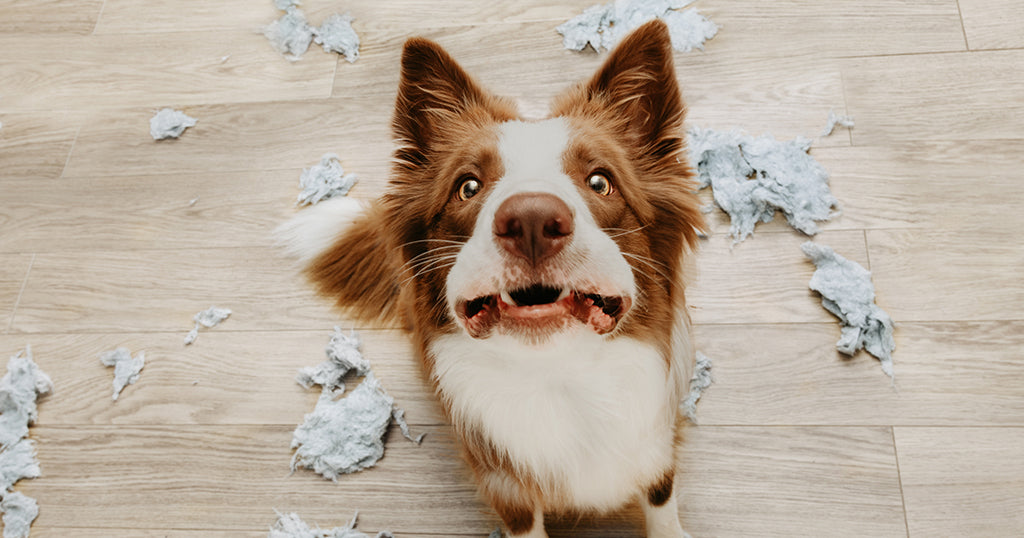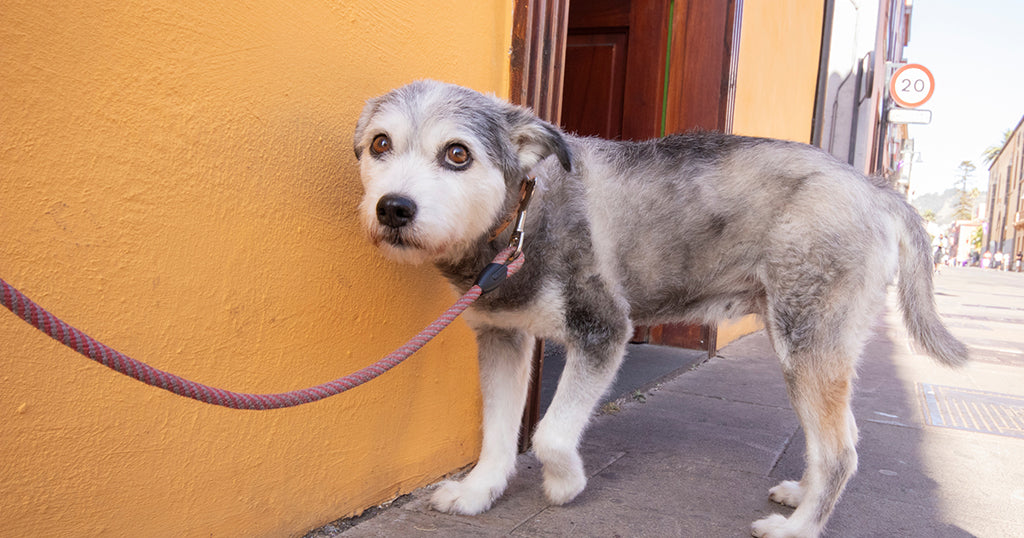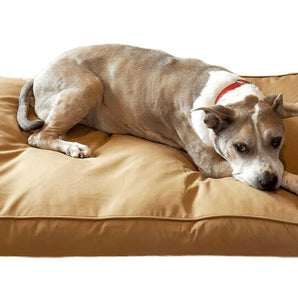Anxiety in dogs is a common problem dog owners face. In fact, a recent study that analyzed 264 dog breeds showed that up to 70% of dogs suffer from anxiety symptoms. An anxious dog may exhibit behaviors such as aggression toward people or other animals, destructive behavior, excessive barking, or having accidents in the house.
As pet parents, we never want our dogs to feel anxious or unhappy, but luckily, there are some things you can do to help your dog cope with anxiety. From behavioral modification techniques to anxiety medication, read on for some tactics for treating dog anxiety.
What is Dog Anxiety?

Dog anxiety is very similar to anxiety in humans—anxious dogs experience feelings of fear, unease, or worry that can be triggered by different factors. Just like people, dogs can feel anxious in certain situations, and their anxiety can manifest in different ways.
When dogs get anxious, it's essentially their nervous system responding to a perceived threat or change in their environment. This can lead to an increase in heart rate, rapid breathing, and a release of stress hormones like cortisol, mirroring the fight or flight response seen when humans experience anxiety
7 Signs of Anxiety in Dogs
In dogs, anxiety signs can vary widely. Some may show obvious signs of distress, like barking, howling, or pacing, while others might exhibit more subtle behaviors, such as licking their lips, yawning, or shedding more than usual. Physical symptoms can also occur, including diarrhea or other digestive issues, and excessive shedding.
1. Aggressive Behavior
When dogs experience anxiety, it can sometimes lead to aggressive behaviors. One common sign is growling, which is a dog's way of showing they feel threatened and might resort to biting if further provoked.
Dogs sometimes growl when they're playing, too. This usually occurs during playtime with humans or other dogs, often when playing tug-of-war or roughhousing. So how can you tell if their growl is anxious or playful?
Their body language when they are playing is much more relaxed; they might wag their tails, have a bouncy or playful posture, and do a "play bow," where the dog lowers its front legs while keeping the back end up.
Anxious growling, on the other hand, comes from a place of fear, discomfort, or aggression. The dog may show a stiff posture with ears pinned back, lips pulled back to bare the teeth, and their tail might be lowered or tucked between the legs.
An anxious dog may also bare its teeth, which is a visual sign showing that they are ready to defend themselves aggressively. Snarling, which is when a dog growls and shows bared teeth, is a sign that they are highly aggravated or anxious and likely to bite.
Another sign is snapping, which almost mimics a bite and is used as a warning to humans or other animals. These behaviors all signal that a dog is uncomfortable with their situation and may act out if the perceived threat isn't removed.
2. Destructive Behavior
Dog anxiety can lead to a variety of destructive behaviors. One common behavior is chewing on inappropriate objects like furniture, shoes, or even walls. Unlike puppy chewing, which is usually done to soothe sore teeth, anxious chewing is a way for dogs to relieve stress.
Some dogs might also engage in excessive digging, either in the yard or in their bedding. This is a natural instinct to try and create a safe space or to escape from what's causing their anxiety. Similarly, they may start scratching at doors or floors, which can be a dog's way to get to their owner or escape from a room where they feel trapped.
3. Drooling or Panting
Drooling and panting are natural physiological responses to stress or nervousness. Panting, which is faster and more shallow than normal breathing, helps to cool dogs down and is a common stress response.
Drooling, on the other hand, can be a bit more direct. While it's normal for some breeds to drool more than others, an increase in drooling can be a sign of anxiety, stress, or fear in dogs. It's their body's response to the adrenaline rush and heightened state of arousal associated with anxiety. Both of these signs, especially in situations that might be stressful for the dog (like during thunderstorms, in new environments, or when separated from their owners), can indicate that the dog is feeling anxious and uncomfortable.
4. Pacing
Dogs sometimes pace as a means of managing anxiety. Anxiety triggers a surge of adrenaline and stress hormones in dogs, putting them in a heightened state that makes them want to move. This pacing is essentially their way of coping with the nervous energy they can't easily dispel. It's like a dog's version of fidgeting or foot-tapping in humans.
5. Urinating or Defecating in the House
Dogs may go to the bathroom inside the house when they're feeling anxious. Just like in humans, stress and anxiety can lead to an urgent need to urinate or defecate. The body's fight or flight response, triggered by anxiety, can stimulate the digestive system and bladder, making it harder for dogs to control these functions.
Sometimes, going to the bathroom indoors is a dog's way of signaling to you that something is wrong. While it may not necessarily be intentional, it's a sign that the dog is under stress and may need help or reassurance.
6. Excessive Barking
When dogs bark more than usual, especially in situations where they don't usually bark a lot, it can be an indication that they're feeling stressed, anxious, or fearful. Anxiety-driven barking tends to occur in specific situations, such as when dogs are left alone (indicating they may have separation anxiety), in response to unfamiliar noises or sights, or when they're in a new or uncomfortable environment. This is their way of showing discomfort or attempting to manage what they perceive as a threat.
7. Repetitive or Compulsive Behaviors
Anxious dogs can engage in repetitive or compulsive behaviors as they try to manage their stress. Dogs may display anxious behavior such as licking or chewing their own body, leading to skin damage or hair loss. Obsessive tail chasing can also be a sign of anxiety, especially if the behavior is frequent and intense.
Triggers For Dog Anxiety

If your dog shows signs of anxious or aggressive behavior, it's a likely sign they may be experiencing anxiety. Before you can help treat your dog's anxiety, you need to figure out where it's coming from. Common triggers for anxiety include separation from the dog's owner, social anxiety, excessive or unfamiliar noises, and travel, among other things.
Separation Anxiety
Many dogs—especially rescue dogs—experience separation anxiety when they're left alone or separated from their caretakers. Dogs with separation anxiety may show symptoms like destructive chewing, incessant barking or howling, or attempting to escape from the house. For example, a dog might chew through a doorframe or destroy furniture shortly after their owner leaves the home, indicating panic rather than disobedience or boredom. An anxious dog who is left in a crate may try to escape, potentially causing injuries like broken teeth, cut gums, or damaged nails.
Social Anxiety
Some dogs experience social anxiety, where they are anxious around unfamiliar people, dogs, or other animals. This can come from a lack of socialization, negative experiences, or even genetics. Dogs dealing with social anxiety might react by hiding, growling, or even snapping when approached by strangers or other animals.
Noise Anxiety
Noise anxiety is a common form of anxiety in dogs, triggered by loud or unexpected sounds like thunderstorms or fireworks. Dogs with noise anxiety may tremble, hide, bark excessively, or try to escape to a perceived safer location. Many people choose to give their dogs an anti-anxiety medications when they anticipate loud noises, such as on 4th of July when they know fireworks will be present.
Travel Anxiety
Sometimes, traveling with our pets is inevitable, but this can be a source of anxiety in dogs. It often shows up as distress or fear associated with traveling in a vehicle or being in a moving object like an airplane. Symptoms include drooling, vomiting, shaking, excessive barking, and refusal to get into the vehicle. Many people will also give anti-anxiety medication to dogs before long road trips or airplane rides.
Age Related Anxiety
Senior dogs sometimes start to develop anxiety as they age. This is often due to cognitive decline, decreased vision and hearing, or increased pain from conditions like arthritis. Anxiety that affects senior dogs can show up as confusion, increased irritability, pacing at night, and less tolerance for change. An older dog, for example, might start barking at familiar people or objects, or become anxious at night, indicating disorientation or discomfort due to aging processes.
General Anxiety
When there's no other obvious sign of anxiety in dogs, it may be general anxiety. General anxiety in dogs does not have a specific trigger like the types mentioned above. Dogs with general anxiety may show constant signs of nervousness, such as panting, drooling, restlessness, and being overly reactive to minor disturbances.
For example, a dog might bark at other dogs or any slight noise or movement within the home and be unable to relax or feel secure even in a familiar, safe environment. Managing anxiety like this often requires a variety of tactics, including environmental modification, behavior therapy, and sometimes medication.
How To Treat Your Dog's Anxiety

If your dog suffers from anxiety, it's natural that you'll want to help calm and comfort them. You can make certain changes to their environment, provide training and behavior modification, or give medications or supplements to help treat anxiety.
Environmental Responses
Creating a calm and secure environment can significantly reduce a dog's anxiety. This can include providing a safe space, like a chew-proof dog bed or a quiet room, where your dog can go when they feel overwhelmed. Playing soft music or using white noise machines can help mask stress-inducing sounds.
Training Techniques
Positive reinforcement training is another powerful tool for managing canine anxiety. This involves rewarding calm behaviors to encourage more of those behaviors. Desensitization and counterconditioning can also be effective; they involve gradually exposing the dog to the source of their anxiety in controlled, low-stress settings and associating it with positive experiences.
Anxiety Medications
In cases of severe and chronic anxiety, a veterinarian may prescribe anti-anxiety medications. These can help manage the symptoms of anxiety, allowing for more effective training and behavior modification. Medications are often used with other treatments and should be closely monitored for side effects.
Supplements and CBD Oil
Anxiety supplements that contain L-theanine, magnesium, or alpha-casozepine, can have a calming effect on dogs. CBD oil is another option that has gained popularity for its potential to reduce anxiety, though research is still ongoing. Be sure to consult with a veterinarian before starting any supplements or CBD oil to ensure they're safe and appropriate for your dog.





